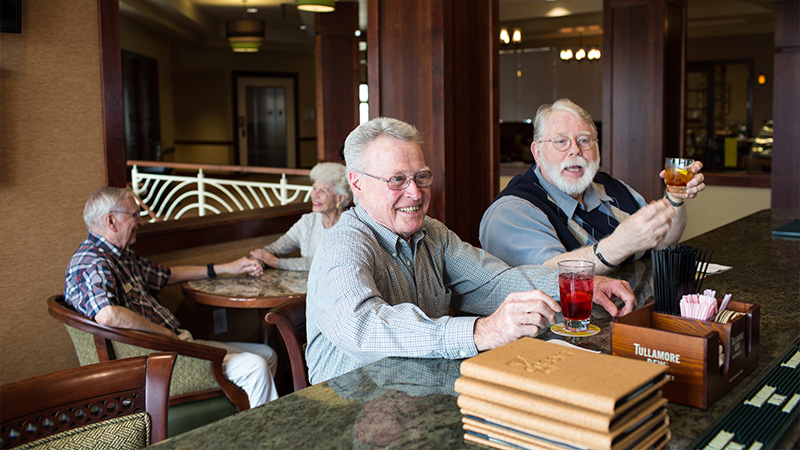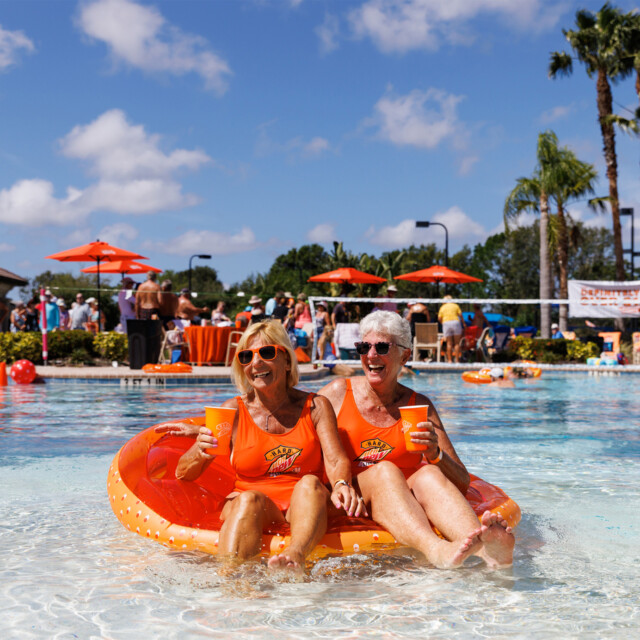Retirement communities aren’t known for their cocktail hours, but as aging residents aim to keep up their pre-retirement routines, it’s not uncommon to encounter a retirement home that holds a liquor license. How they’re then used can be as simple as providing mixed drinks at a round of bingo, or as elaborate as poolside bars designed with the party-seeking (senior) patron in mind.
Of course, some communities sway on the wilder side of bar service. The most notorious example is The Villages, a sprawling community covering over 33,000 acres in Florida that’s associated with raucous parties, a thriving swingers scene, and regular parties.
Elsewhere in Florida, poolside parties provide novel social gatherings for residents. This spring, Hard MTN Dew also launched a tongue-in-cheek campaign to introduce its newest citrus flavor, including an exclusive party at a Florida retirement community — a nod to an age-related controversy involving the brand. (A Hard MTN Dew representative claims that, in doing so, the brand became the first major producer to host a product debut in such a setting.)
Hosted at Cypress Falls at the Woodlands, 300 residents of the residential community joined the brand for a poolside bash. “Cypress Falls is where it’s happenin’,” one resident, identified simply as Nick, said in a brand video while tipsily swaying next to his wife Joan.
It’s far more likely that you’ll encounter something a bit more toned-down after retirement — think sipping Manhattans rather than shotgunning boozy line extensions from energy drink brands. From Champagne service to spending afternoons over a game of poker, the best party years are now post-retirement.
Fulfilling a Tall Order
Enjoying drinks at a typical retirement community might take the form of weekly happy hours or a tasteful pub. At the heart of most senior happy hours is a well-intentioned sense of community and structured social bonding. In the same way that 20-somethings come together over a round of Margaritas, retired adults in assisted living facilities continue to enjoy catching up with pals over a drink.
“When the [University of Nebraska football team] Nebraska Huskers play, the pub is always really crowded. There’s a good amount of beer drinking going on,” Hillcrest Estates owner Jim Janicki says. “It’s kind of like being in college without having to go to classes.”
As Nebraska’s Hillcrest Estates is within miles of an Air Force base, Janicki says many residents are veterans used to socializing in a drinks-focused setting. Good food and familiar beers unite residents at the pub and adjoining games room, he says.
Bonding with Buddies Over a Drink
While regulations vary by state, retirement communities are generally permitted to serve alcohol under a standard liquor license. Some states, like Montana, recently passed legislation to allow limited drinks service in these communities under specific conditions. Last call, for example, is at 8 p.m.
Navigating that red tape can be a difficult and long process, especially when pursuing the first license of this kind in a state. In 2015, Hillcrest Estates became the first continuing care community to receive a liquor license in Nebraska. Janicki led the launch of the community’s luxury pub, a bistro-style dining space and bar. Founder Jolene Roberts envisioned a pub within the community, Janicki says, so residents could socialize before and after dinner.

While acquiring the liquor license, state representatives were equally new to the process. “It was actually quite tricky,” Janicki says. “As we did research and figured things out, the state wasn’t even sure who would have jurisdiction.”
When drinking at a retirement community, though, all the typical bar service and liquor license regulations apply. In most communities, there’s (usually) an unspoken two-drink limit and only one bartender is needed per shift.
During happy hour at Fox Run at Orchard Park near Buffalo, N.Y., residents can order anything from a top-shelf cocktail to a craft beer. Marketing director Mary Lou Letina-Land says the retirement community never cancels its twice-weekly happy hour, as residents especially love the social gatherings. Similar to Hillcrest Estates, Fox Run holds a full New York State liquor license and serves any cocktails the residents desire.
At Fox’s Den’s bar, sole bartender Dennis Nowicki serves up classics like Martinis, Old Fashioneds, and Manhattans. Fox Run also adds excitement by inviting guest bartenders to handle service for the night, like Fox Run executives or well-loved employees. Even during the height of the pandemic, Letina-Land says, happy hour never ceased. Employees hand-delivered individual Champagne carts (with pairings of ice cream and other treats) to residents as they socialized over video chat.
“Just like people in their 20s and 30s, [the residents] like to have house parties,” Letina-Land says. “But they also like to go out to a bar and have a good time.”
Themed happy hours at the Fox’s Den are a standout, and residents can enjoy Monte Carlo-themed bashes and New Year’s Eve celebrations. Maintaining that sense of community and social life is key to vitality, as gerontologist Ashwin Kotwal says.
“I tend to encourage people to socialize, and if alcohol is something that’s enjoyable to them, to [drink] safely in social situations,” he says. “Like most things, alcohol is good when it allows us to engage with the world and get more out there.”
Whether consuming alcohol or not, physical spaces and scheduled social time can help maintain residents’ sense of belonging. Sometimes, though, gatherings at some retirement communities can go too far.
Party Fouls and Potential Risks
While spending retirement days poolside sounds like a version of paradise, some communities can take things to an extreme. There’s no age limit on bad behavior, it seems.
A documentary on the The Villages, “Some Kind of Heaven,” premiered in theaters in 2020. It explores life within the community — and a darker aspect of its debaucherous “paradise.” Its 138,000 residents operate in an almost uncanny space — endless rows of cheery houses and fake historic monuments included — conjuring connections to films like “The Truman Show.” The trailer opens with a meeting of the Elaine is Our Name Club, an eerie gathering centered on individuals with the same name:
If the creepy optics don’t shake you, perhaps the community’s darker side of skewed politics and record of racist incidents do. The Villages’ wide Republican voter turnout in 2016 is associated with Donald Trump’s successful election and subsequent events — a 2020 video captured a group of thousands of supporters shouting racist phrases during a “golf cart rally,” according to the Daily Mail. The former president retweeted the video (and later deleted it), a move that was widely condemned as blatantly racist.
Typically, though, that type of behavior doesn’t happen in most residential communities. Everyday bar considerations instead sway medical-wise, as consuming alcohol can present more issues among older adults. Kotwal says seniors should speak to their primary physicians about settings and quantities that work best for them.
“It depends on each person. When we’re making clinical decisions, we try to consider any underlying risk factors and any potential benefits here,” he says. “I generally suggest people to suggest to their physicians on the level of alcohol that’s safe to consume, depending on the type of medications they’re on, other underlying health factors, and just their individual preference.”
A variety of risk factors, such as potential falls, can be especially concerning. Kotwal advises caution, noting that older adults are safer sticking to alcoholic drinks that are familiar to them. Regular beer drinkers suddenly ordering a Martini is unadvisable, he says.
Planning Your Retirement
Even after retirement, there’s no need to nix the after-work happy hour. For those thinking ahead to retirement days, there are quite a few additional amenities and safety aspects to consider.
Senior-focused bars and pubs typically have unique design specs for bar height, furniture, and layout. When considering Hillcrest Estate’s bistro area, Janicki says, the executive board chose seating that would be easily accessible by residents of all activity levels.
Pennsylvania-based architecture firm RLPS, which specializes in senior living design, advises a bar height of 30–36 inches — a slightly smaller stature than the standard 42 inches — to allow easy accessibility. Seating with firm backs and armrests can provide ease in standing up and sitting down, too.
At Hillcrest Estates, Janicki also employs a locked liquor cabinet to curb consumption when the bar isn’t in use. Other precautionary measures — including installing liquor lockers to store residents’ personal bottles and supervised consumption — contribute to a safe and fun drinking experience.
Under the right conditions, on-site pubs at residents’ communities extend pre-retirement routines to well past the age of 55. Enjoying a glass of Pinot with dinner or splitting a pitcher of beers with friends helps residents maintain an active social life and sense of normalcy, as the BBC explored in a recent feature. Not every community serves up cans of Hard MTN Dew while playing bridge poolside — and for many people, that’s perfectly fine.
Maintaining a sense of independence through your later years is key to a fulfilled, well-rounded lifestyle. Regular happy hours — for those who choose to drink — are definitely included.
